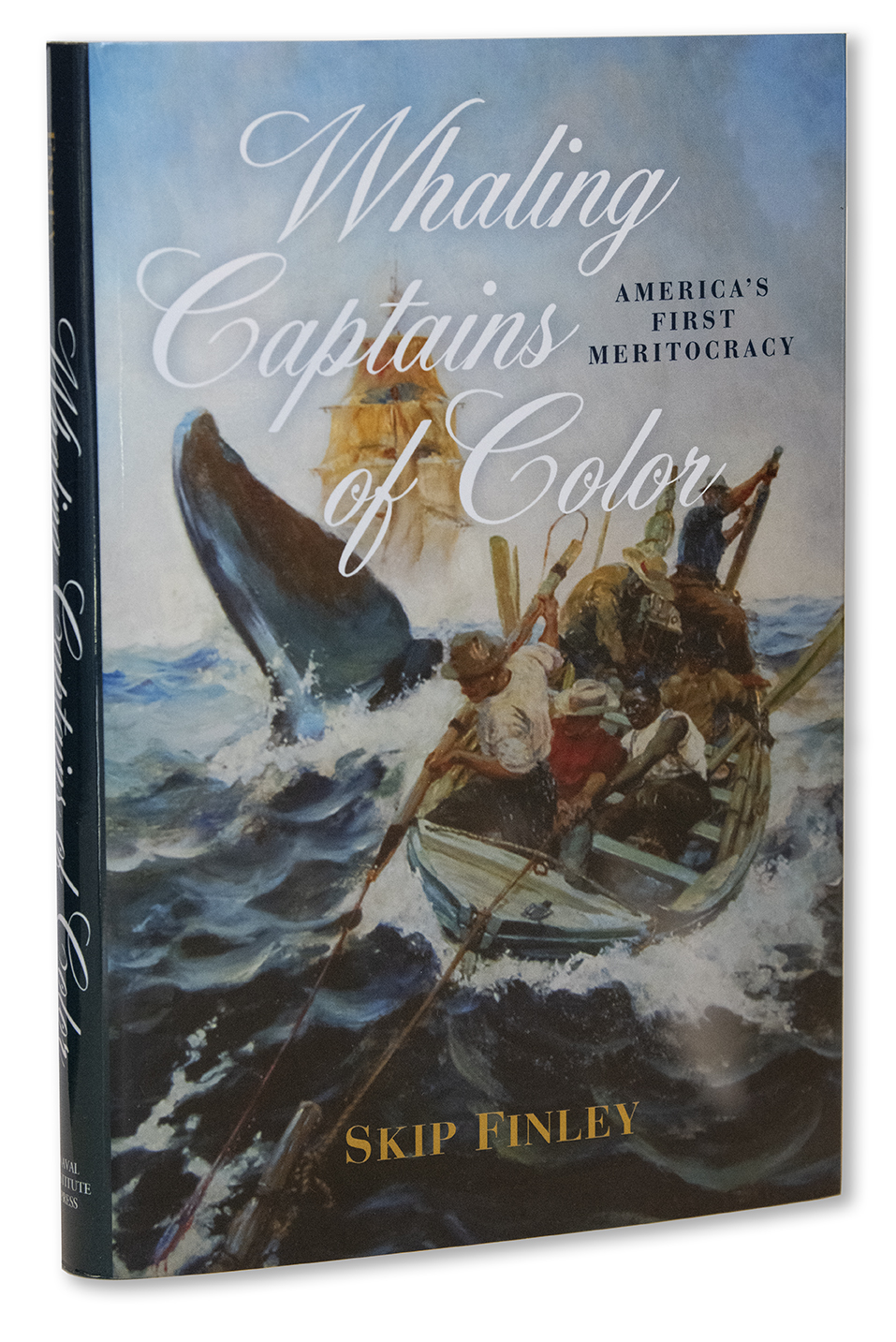Whaling Captains of Color
America's First Meritocracy By Skip Finley
By Monica Allard CoxWhaling was not a profession most crew members would choose if they had better options. Skip Finley paints a harrowing picture of whaling and how its very nature—dangerous, difficult, and remote—allowed an intrepid few Africans, African Americans, Native Americans, Cape Verdeans, and other people of color to attain the role of whale ship captain when limited opportunities were available to them, especially on land. Finley’s book, Whaling Captains of Color: America’s First Meritocracy, is a compendium of stories of these men from whaling’s rise in the late 18th century to its decline the early 20th century.
The individual portraits of each captain are woven together with Finley’s keen observations and analysis about the men, the significance of their voyages, and the social, political, and economic contexts of their times.
As Finley describes the second-most hazardous occupation of its day (after mining): “There were hundreds of ways to die on a whaleship. Crewmen fell to their deaths from the ship’s rigging, were slain by Native Americans, died from scurvy or other ailments, were dragged underwater by fouled lines, were killed while cutting in or while fighting whales, and drowned or died from other accidental causes.” Even when not fatal, a whaling voyage—which could last years—was certainly brutal. Crewmen suffered severe boredom when days or weeks passed and no whales were to be found. They choked down maggot-infested food. Even after flogging had been outlawed, it was meted out as punishment on whaling ships, and troublesome crew members could even be restrained in irons. When whales were captured and slaughtered, the butchering and processing was gruesome. Finley quotes from a whaler’s writing in 1856: “Everything is drenched in oil, shirts and trousers are dripping with the loathsome stuff. The pores of the skin seem to be filled with it. You feel as though filth had struck into your blood and suffused every vein in your body. From this smell and taste of blubber, raw, boiling, and burning, there is no relief or place of refuge.” To clean the ship’s decks of this slippery stuff, crewmen used buckets of their own urine.
Given these harsh realities, whaling was something most crewmen only did once. But its very difficulty presented opportunities to crewmen of color, who could rise through the ranks thanks to their ability to capture whales, lead others, and return home safely—and profitably.

These men led whaling voyages to every part of the globe; indeed, several contributed to the mapping of the world’s oceans.
All this despite the fact that in addition to the perils confronting all whaling crews, they faced additional threats—before slavery was outlawed, they could be captured and enslaved or imprisoned at ports from North Carolina to Louisiana. The federal Fugitive Slave Acts further endangered the freedom of these men in any port, and indeed, the Northern states were not innocent—Rhode Island’s notoriety in the slave trade meant that only one captain of color hailed from the state, and that occurred long after the Civil War had ended.
Finley writes that the Massachusetts ports of Nantucket and later New Bedford drew a number of Black whalers, as the area’s Quakers were heavily invested in the industry, and they were strong abolitionists. However, their motives were not entirely altruistic.
They knew that crewmen of color would accept lower pay than those who were white. This was equally true even after slavery was abolished. After the Civil War, as African American whalemen found less dangerous and equally, if not more, lucrative work, Cape Verdeans, fleeing famine in their homeland, took their places.
And it would take most of those men many more years than their white counterparts to command a whaleship. Despite these challenges, several whalemen of color became captains, often when the original captain could not, or would not, continue in the role.
Finley tells the stories of all the captains of color that he can identify from the historic record, from the obscure to the notable, such as Paul Cuffe, who were able to amass considerable fortunes in their lifetimes. Still, he finds, these men were rarely able to pass their wealth along to subsequent generations, perhaps because racism prevented their finding the investment opportunities available to white captains.
The few traces that whaling captains of color left behind seem to fuel Finley’s desire to record the names and histories of those he can glean any information about. He writes that since his research for the book, he looks at the familiar streets of Martha’s Vineyard, where he summers, in a new light. “These men led whaling voyages to every part of the globe; indeed, several contributed to the mapping of the world’s oceans. They were adventurous, enacious, fearless, and ruthless …. Unlike their white counterparts, they left no glistening white waterfront homes behind as testaments to their courage; to their families, they left only pride.” Finley writes. “Little remains today of their accomplishments—tales of valor and a few monuments are all. It would be a tragedy to forget them.”
A Voyage of Discovery
Skip Finley spoke about Whaling Captains of Color: America’s First Meritocracy at the Coastal Perspectives Lecture Series sponsored by the Connecticut Sea Grant College Program, the University of Connecticut (UConn) Department of Marine Sciences, the UConn Maritime Studies Program, and the UConn Avery Point Campus Director’s Office.
To see the recorded lecture, visit https://marinesciences.uconn.edu/cplecture1/
Contact Us
Telephone: (401) 874-6805
Email: allard@uri.edu
Contributor Guidelines
Please review submission guidelines to be considered. d

